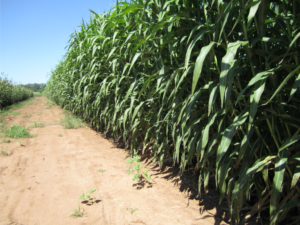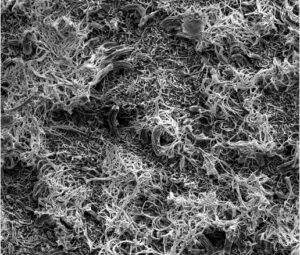Bioenergy sorghum wax, a potentially valuable coproduct, enhances crop’s resilience
In addition to providing protection from drought, heat and pests, wax could generate extra revenue for producers
Already valued for its resilience, biomass production and ability to improve soil fertility, bioenergy sorghum has another attribute that researchers have recently characterized: high wax production.

Plant waxes are useful across a wide scope of commercial products like cosmetics, inks and candles, and as edible food coatings and biofuels. Bioenergy sorghum’s production of high wax loads — around 90-180 pounds per acre — might give growers additional profit.
Scientists within Texas A&M AgriLife Research and the Texas A&M College of Agriculture and Life Sciences are learning more about the plant’s wax. Robert Chemelewski, a doctoral student in the Department of Biochemistry and Biophysics, carried out research with supervision from John Mullet, Ph.D., University Distinguished Professor and Perry L. Adkisson Chair in Agricultural Biology. Their study was recently published in the journal Frontiers in Plant Science.
Importance of wax for sorghum’s resilience in harsh environments
Sorghum, a drought- and heat-tolerant grass, is typically used for production of grain, forage and biomass for bioenergy. Bioenergy sorghum grows very long stems that can reach up to 18 feet tall.
The plant’s resilience allows it to be productive even when grown on marginal land or with little water. This resilience is due in part to the plant’s high wax production, which helps limit water loss and prevent the plant from absorbing too much heat by reflecting solar radiation.
“Bioenergy sorghum spent 50 million years surviving in Africa, in a very hot, dry environment,” Mullet said. “To survive drought at high radiation loads, the sorghum adapted by secreting a lot of wax on the surfaces of leaves and stems.”
Additionally, researchers suspect that the wax increases pest resistance.
“If you mutate plants to remove waxes, they become much more susceptible to insects,” Mullet said. “Insects crawling up the stem encounter a very thick wax layer. So, we think wax helps protect the stem from insect damage.”
Characterizing sorghum’s wax composition
In their recent study, the researchers sought to identify key information about sorghum wax, such as the amounts on different plant surfaces and its chemical composition.

“Wax is made up of long-chain hydrocarbons,” Mullet said. “We found bioenergy sorghum wax is enriched with aldehydes, a type of organic compound, which may contribute to the plant’s pest defense.”
Next, the team examined the biochemical processes involved in bioenergy sorghum’s wax production. They found the wax biosynthesis genes by using prior knowledge obtained from other plants.
Once those were identified, they confirmed that the genes were expressed in the outer layer of the stem, where the wax is synthesized and deposited. The team then analyzed the activation process of wax biosynthesis during stem development, allowing them to see which genes are involved in regulation.
“By the end, we were able to see how the whole pathway fit together,” Mullet said.
Looking ahead to commercialization
Down the line, growers of bioenergy sorghum may be able to see a financial benefit from the plant’s wax in addition to income the crop generates as a feedstock for biofuels and biopower generation.
“We’re always looking for ways we can extract a value-added product from the plant prior to converting it into biofuel,” Mullet said. “When harvested biomass goes to a biorefinery, you could remove the wax early in the process for later purification and sale as a valuable coproduct.”
Mullet said the research team is unsure about the market potential of bioenergy sorghum wax, but now that they know how much the plant produces, they hope to investigate commercial viability.
“We keep learning things about bioenergy sorghum that are just amazing,” he said. “The wax could have a lot of uses. Finding out how it can be removed and recovered economically is the next step in this type of research.”


